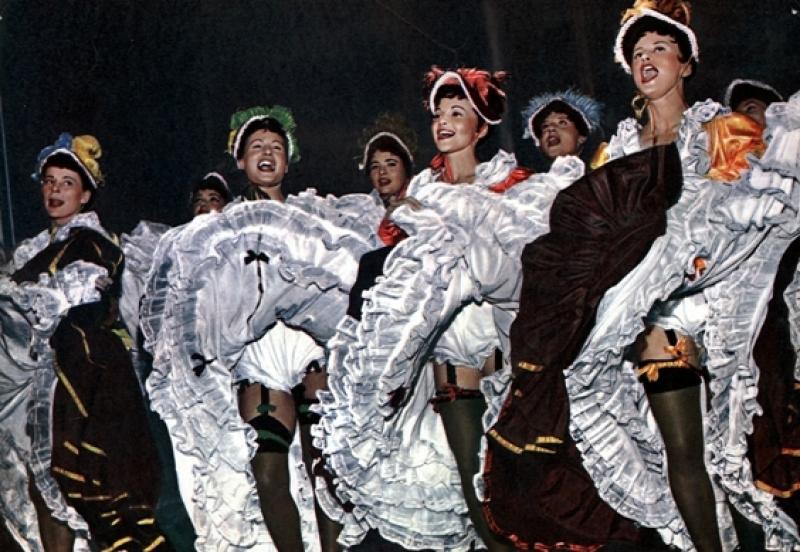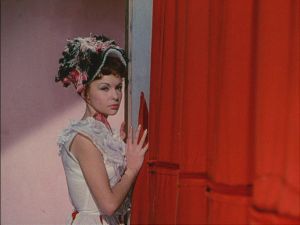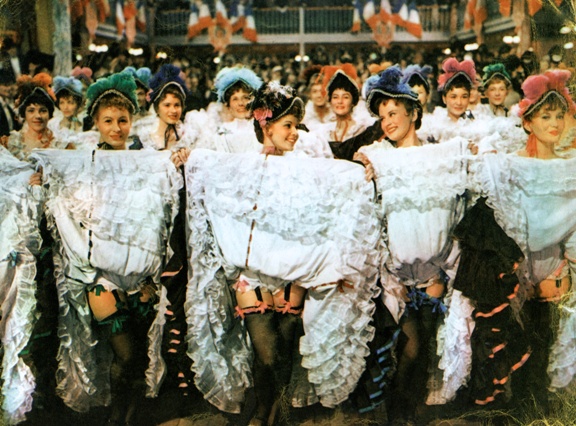French Cancan: Jean Renoir in the Moulin Rouge | reviews, news & interviews
French Cancan: Jean Renoir in the Moulin Rouge
French Cancan: Jean Renoir in the Moulin Rouge
The French director's exuberant homecoming masterpiece is re-released

When Jean Renoir returned to France at the end of 1953 after 13 years of exile, he felt as if he were beginning his career from scratch. His Hollywood films were not highly regarded, and neither The River (1951) nor The Golden Coach (1953), shot in India and Italy respectively, were successful enough to redeem his international standing among reviewers or at the box office. The critical consensus declared that he was an artist in decline.
Cahiers contradicted the received opinion that the American Renoir was only a pale reflection of the French. André Bazin, the editor of the magazine, considered that Renoir’s style in Hollywood had been pared down in an almost mystical manner. Maurice Scherer (later known as Eric Rohmer), a contributor to Cahiers, claimed, "Genius has no decline," and considered The Southerner (United Artists, 1945) "the apex of Renoir’s work".
French Cancan was to be Renoir’s first French film for 15 years, and his first original screenplay since This Land is Mine (RKO, 1943). Based on the life of Charles Ziedler, the man who founded the Moulin Rouge, it was a story that went back to Renoir’s roots in Montmartre, the world of his childhood and of his father, the Impressionist painter August Renoir. (During the shooting the Ziedler family objected to the use of their name, and the producers had to change it to Danglard.)
In order to gather a cast familiar with the caf’ conc’ milieu, Renoir visited a number of Paris cabarets in search of talent. From there he drew Phillipe Clay and Jean-Roger Caussimon, as well as famous singers such as Edith Piaf and Patachou; from the theatre Michel Piccoli (who had only made three films since his screen debut five years before), and others Renoir had worked with before World War Two.
Watch the trailer for French Cancan
In the lead, Jean Gabin expressed his delight at working with Renoir after all these years. Their previous collaborations had been on The Lower Depths (1936), La grande illusion (1937) and La bête humaine (1938). In the interim Gabin had gained the reputation of being a disagreeable, bad-tempered character, always grumbling and difficult to please. When Renoir was warned of how ill-natured the actor had become, Renoir’s wife Dido said, "You’ll see. Jean can turn Gabin around his little finger." Which is exactly what happened. On the set, Gabin was submissive to every suggestion of Renoir’s. "I love Gabin and he loves me," wrote Renoir. "But we do not know one another… Our relationship is entirely professional, but I have the feeling that his tastes are pretty much the same as mine. We run across each other at the same restaurants. When we worked together we had no need of lengthy discussion to analyse the situation. We scarcely needed a script to know what we had in mind."
 Mexican star Maria Felix, who was living in France at the time, was cast as Gabin’s temperamental mistress, La Belle Abbesse, and Françoise Arnoul (pictured right) was Nini, her young rival for his affections. Renoir had had Leslie Caron in mind when he wrote the part of Nini, the laundress who becomes a Cancan dancer. However, the French producer, Louis Wipf, did not want her, considering her too "foreign" and too much associated with Hollywood. The French actress-dancer had recently triumphed in MGM’s Lili, and was a friend of Renoir’s. Twenty-three-year-old Arnoul, who bore a striking resemblance to Caron, was the only name that would sell the film, according to the producers – not Gabin nor Renoir. Before Bardot superseded her, Arnoul was known as a sex kitten in films like Forbidden Fruit, Inside a Girls’ Dormitory and The Bed, all considered the height of Gallic naughtiness abroad.
Mexican star Maria Felix, who was living in France at the time, was cast as Gabin’s temperamental mistress, La Belle Abbesse, and Françoise Arnoul (pictured right) was Nini, her young rival for his affections. Renoir had had Leslie Caron in mind when he wrote the part of Nini, the laundress who becomes a Cancan dancer. However, the French producer, Louis Wipf, did not want her, considering her too "foreign" and too much associated with Hollywood. The French actress-dancer had recently triumphed in MGM’s Lili, and was a friend of Renoir’s. Twenty-three-year-old Arnoul, who bore a striking resemblance to Caron, was the only name that would sell the film, according to the producers – not Gabin nor Renoir. Before Bardot superseded her, Arnoul was known as a sex kitten in films like Forbidden Fruit, Inside a Girls’ Dormitory and The Bed, all considered the height of Gallic naughtiness abroad.
Subtitled "Une comedie musicale", French Cancan surpasses many of the best Hollywood musicals, as well as being superior to other approaches to the period and subject, including Moulin Rouge (1953), John Huston’s biopic of Toulouse-Lautrec. Although it contains some of the formula elements of the musical – there is a montage of scenes as a couple go on a tour of all the Paris nightspots, and Gabin hears a woman singing outside his window and employs her – it is never trivial. The screenplay deals with the dedication and sacrifices needed for art, and the difficulties of romantic relationships, in a manner that few directors have been able to carry off – at once profound and light, proving that they are not mutually exclusive.
All the various relationships are established during the sequence at a popular Montmartre café, La Reine Blanche, where Gabin, his mistress, and hangers-on go slumming, and meet the laundress and her boyfriend – a scene that evokes Don Giovanni’s arrival at Zerlina’s wedding in the Mozart opera, not as distant a comparison as it would seem. Mozartian is an adjective that often comes to mind when describing a number of Renoir films, especially La règle du jeu, and the romantic, Technicolor period trilogy of which French Cancan is between The Golden Coach and Elena et les hommes (1956).
The film draws the audience into the world of La Belle Époque, recognisable from many of the familiar paintings, posters and engravings, without imitating any particular style. There is seldom a dead space on the screen, and yet the frame never gives the impression of being busy or cluttered.
Gabin, now grey-haired and portlier than when he last worked for Renoir on La béte humaine, gives a remarkably shaded performance, tender and passionate. As Renoir’s surrogate, he utters the cri de coeur: "We artists are at the mercy of the men with money." And in his last speech, justifying his profession and the need for freedom, "The only thing that counts is what I create; the only thing that counts is to serve the public."
 The final sequences are examples of Renoir at his technical and creative best. At a corner café outside the Moulin Rouge, a couple, who had commented negatively throughout on the building of the theatre, suddenly decide to join the queue of eager patrons who crowd in for the premiere. As the show commences, relationships are being worked out backstage, then the noisy audience is stilled by a singer as she moves among them singing the haunting theme song, "La complainte de la butte", written by Georges Van Parys, with lyrics by Renoir. The screen then explodes with music, dancing and colour as the Cancan takes possession of the whole auditorium, the white dresses and black stockings flashing at the camera, the apotheosis of exuberance.
The final sequences are examples of Renoir at his technical and creative best. At a corner café outside the Moulin Rouge, a couple, who had commented negatively throughout on the building of the theatre, suddenly decide to join the queue of eager patrons who crowd in for the premiere. As the show commences, relationships are being worked out backstage, then the noisy audience is stilled by a singer as she moves among them singing the haunting theme song, "La complainte de la butte", written by Georges Van Parys, with lyrics by Renoir. The screen then explodes with music, dancing and colour as the Cancan takes possession of the whole auditorium, the white dresses and black stockings flashing at the camera, the apotheosis of exuberance.
The rapid montage of the dance is cut in with close-ups of Gabin, sitting alone backstage, progressively registering anxiety, then contentment, then joy, counterpointed with the faces of various couples in the audience. The last image is a long shot of the exterior of the Moulin Rouge, in front of which a drunk, barely perceptible, is reeling across the road. He suddenly turns, takes off his hat, and bows to the cinema audience.
Most French audiences and critics appreciated Renoir’s homage to the painters and popular Parisian theatre of the Second Republic when it opened in April 1955, although the film did less well in the USA under the fatuous title Only the French Can. Nevertheless, it was clear that after the American, Indian and Italian experience, Renoir had returned to his artistic home – la belle France.
- French Cancan goes on release on 8 August
 Find Ronald Bergan's Jean Renoir: Projections of Paradise (Bloomsbury) on Amazon
Find Ronald Bergan's Jean Renoir: Projections of Paradise (Bloomsbury) on Amazon
Share this article
Add comment
The future of Arts Journalism
You can stop theartsdesk.com closing!
We urgently need financing to survive. Our fundraising drive has thus far raised £49,000 but we need to reach £100,000 or we will be forced to close. Please contribute here: https://gofund.me/c3f6033d
And if you can forward this information to anyone who might assist, we’d be grateful.

Subscribe to theartsdesk.com
Thank you for continuing to read our work on theartsdesk.com. For unlimited access to every article in its entirety, including our archive of more than 15,000 pieces, we're asking for £5 per month or £40 per year. We feel it's a very good deal, and hope you do too.
To take a subscription now simply click here.
And if you're looking for that extra gift for a friend or family member, why not treat them to a theartsdesk.com gift subscription?
more Film
 After the Hunt review - muddled #MeToo provocation
Julia Roberts excels despite misfiring drama
After the Hunt review - muddled #MeToo provocation
Julia Roberts excels despite misfiring drama
 London Film Festival 2025 - Bradley Cooper channels John Bishop, the Boss goes to Nebraska, and a French pandemic
... not to mention Kristen Stewart's directing debut and a punchy prison drama
London Film Festival 2025 - Bradley Cooper channels John Bishop, the Boss goes to Nebraska, and a French pandemic
... not to mention Kristen Stewart's directing debut and a punchy prison drama
 Ballad of a Small Player review - Colin Farrell's all in as a gambler down on his luck
Conclave director Edward Berger swaps the Vatican for Asia's sin city
Ballad of a Small Player review - Colin Farrell's all in as a gambler down on his luck
Conclave director Edward Berger swaps the Vatican for Asia's sin city
 London Film Festival - from paranoia in Brazil and Iran, to light relief in New York and Tuscany
'Jay Kelly' disappoints, 'It Was Just an Accident' doesn't
London Film Festival - from paranoia in Brazil and Iran, to light relief in New York and Tuscany
'Jay Kelly' disappoints, 'It Was Just an Accident' doesn't
 Iron Ladies review - working-class heroines of the Miners' Strike
Documentary salutes the staunch women who fought Thatcher's pit closures
Iron Ladies review - working-class heroines of the Miners' Strike
Documentary salutes the staunch women who fought Thatcher's pit closures
 Blu-ray: The Man in the White Suit
Ealing Studios' prescient black comedy, as sharp as ever
Blu-ray: The Man in the White Suit
Ealing Studios' prescient black comedy, as sharp as ever
 The Woman in Cabin 10 review - Scandi noir meets Agatha Christie on a superyacht
Reason goes overboard on a seagoing mystery thriller
The Woman in Cabin 10 review - Scandi noir meets Agatha Christie on a superyacht
Reason goes overboard on a seagoing mystery thriller
 London Film Festival 2025 - crime, punishment, pop stars and shrinks
Daniel Craig investigates, Jodie Foster speaks French and Colin Farrell has a gambling habit
London Film Festival 2025 - crime, punishment, pop stars and shrinks
Daniel Craig investigates, Jodie Foster speaks French and Colin Farrell has a gambling habit
 I Swear review - taking stock of Tourette's
A sharp and moving tale of cuss-words and tics
I Swear review - taking stock of Tourette's
A sharp and moving tale of cuss-words and tics
 A House of Dynamite review - the final countdown
Kathryn Bigelow's cautionary tale sets the nuclear clock ticking again
A House of Dynamite review - the final countdown
Kathryn Bigelow's cautionary tale sets the nuclear clock ticking again
 theartsdesk Q&A: Idris Elba on playing a US President faced with a missile crisis in 'A House of Dynamite'
The star talks about Presidential decision-making when millions of lives are imperilled
theartsdesk Q&A: Idris Elba on playing a US President faced with a missile crisis in 'A House of Dynamite'
The star talks about Presidential decision-making when millions of lives are imperilled

Comments
...